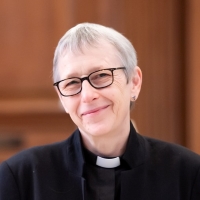The experience of lockdown was a time of immense challenge and uncertainty for all of us – and tragically has had serious and sometimes even damaging consequences for many.
But for some of us it has also triggered some positive changes to our lifestyles, and our priorities, and to the pattern of our day. For example, it prompted me to start walking everywhere, instead of using public transport, which brought with it all kinds of benefits. And in addition to that, finding myself with more time than usual to attend to my spiritual life each morning, I got into the habit of reading about, and reflecting upon, religious works of art, as part of my daily discipline of prayer.
Which was great – because sometimes a visual image can inform your reflections and challenge your assumptions about a well-known Biblical story in a wonderfully new and creative way.
And so it was that, reading a book about religious art during lockdown, I chanced upon a painting by the artist John Reilly, who died in 2010, which spoke to me so powerfully, that I had to have it in my life – so I purchased a large copy of it, printed on stretched canvas. The painting, which I shall share with you in a moment (link below), is directly connected with the theme of our Gospel reading today, which will be my starting point.
Today’s reading, taken from the very beginning of St Mark’s Gospel, describes the call of the first disciples. As we heard, Jesus is walking along by the sea of Galilee, where he sees two sets of brothers, who were fishermen – Simon and Andrew, and James and John. ‘Follow me’, says Jesus, ‘and I will make you fishers of men.’ And remarkably they simply drop everything that they are doing and do precisely that.
Let’s just pause for a moment and think about that scene in a bit more detail. Imagine for a moment that Jesus happens to be strolling past Kwik Fit in Croydon, where he sees four men at work, servicing cars – and he says to them – ‘Follow me, and you will be issuing MOT certificates in the Kingdom of Heaven.’ The biblical story really is that bizarre. Note first of all, whom it is that Jesus calls. They are totally ordinary working men. They are not holy, or wise, or insightful, and they are certainly not educated – quite the opposite. They are just mundane human beings like us, trying to earn a living – only without most of the privileges that we enjoy. And what is even more weird is that the disciples do exactly as he tells them – they drop everything and follow him. There is something about the person of Jesus – about his very presence – that is so compelling that they realise in that split second that this is what they must do – it is an incredibly powerful scene.
And note also that what Jesus offers them when he calls them is not the prospect of an exalted and glamorous future – but rather that of doing what they are already doing – but doing it for God. They will continue to be fishermen in the new life to which he is calling them – but the fishing they will be doing will be of a wholly different order.
These motifs are also picked up elsewhere in the Gospels. The story of the call of Simon (later called Peter) in Luke Chapter 5, is similar, but linked with the story of the miraculous catch of fish. In that story, Jesus gets into Simon’s boat and asks him to put out a little from the land. From there he addresses the crowd of people who were following him, who had gathered on the land. When Jesus has finished speaking, he tells Simon to go out deeper into the water and cast his nets. Simon is pessimistic, reporting that they have been fishing all night and have caught nothing – but nevertheless he does as he is asked.
The resulting catch of fish is so enormous that the nets are full to bursting, to the point where the boat is in danger of sinking. Simon is terrified, conscious that he is experiencing something that truly is of God. And what does Jesus says to him? ‘Do not be afraid; henceforth you will be catching men.’
Think about the sequence of events in this story: Jesus begins by speaking to the people – then he encourages the disciples to fish, even though they do so without any hope of results – and the resultant catch far exceeds anything that they had ever thought possible. Again, as we see, it is linked with Jesus’s charge to Simon to become a fisher of men. (Apologies for the non-inclusive language by the way – I have yet to find a satisfactory alternative translation.)
We find a different version of the story of the miraculous catch of fish at the end of St John’s Gospel, which takes place after the death and resurrection of Jesus. In this story, it is Simon Peter himself who decides to go out fishing, accompanied by some of the other disciples, but all night they catch nothing. At daybreak the Risen Christ appears on the shore and says to them, ‘Children, have you any fish?’ ‘No’, they reply. ‘Cast your nets the other side’, he says, and once again the catch of fish is so enormous that they are unable to haul it in.
So in these three stories, from three different Gospels, we can see how the motifs of discipleship, ministry and mission are all profoundly interconnected, and woven around the themes of fishermen and fishing.
Let me now turn to the painting that I mentioned earlier (click to see painting). The artist John Reilly was fascinated by biblical stories (and also, incidentally, had a great love of the sea, which I think is apparent from the image I am about to share with you). But what interested him was not reproducing a literal interpretation of Gospel scenes – but rather with drawing out the spiritual significance of such stories for the onlooker. As you can see this painting is stylised and abstract – but goodness me does it get to the very heart of the Gospel story, drawing together so many of the themes we have touched upon already – and much more besides: themes to do with Creation, and the story of Jesus walking on the water – there is so much there to find! So, why do I love this painting so much?
Firstly, I love the way in which the images of fish and human beings are so beautifully woven together and so integrally linked that you simply can’t tell them apart. I love the fact that the Christ figure is clearly recognisable as human, like the disciples, yet glows with a wonderful ethereal light. He empowers them, but with a gentle, beautiful, life-giving power, that simply flows out of him. I love the movement of the sea, and the blaze of the sun, illuminating the picture with a divine light. I love the fact that the fish motif, which binds the whole painting together, continues into the very heavens – where it is there, but just out of reach – a wonderful image of interconnectedness reminding us that what we do on earth is profoundly connected with the life of heaven.
But perhaps the thing that speaks most powerfully to me is this. Seen as a whole, you can delight in the wonderful coherence of this image, where everything is linked with everything else, giving each element within it identity and purpose. But seen close-up, the picture is made up of strange little curved and irregular shapes, some of them very distorted, and in dark and apparently rather unattractive colours.
I find that quite a lot of what I do each day can sometimes feel as if I am dealing with a series of unpromising, isolated, sometimes rather ugly little fragments – because that is the nature of human life and human ministry. At times it can be hard to see beyond that difficult encounter with the individual you find it so very hard to like, or that boring administrative task, or the pastoral conversation that seems to be getting nowhere – in order to glimpse the bigger picture that, in fact, and quite paradoxically, is made up of precisely these small, unpromising, and apparently inconsequential bits of life. I look at this painting every single morning as I prepare for each new day, in order to remind me of that.
Because this really is the stuff of ministry – and the stuff of discipleship. That is why Jesus went out of his way to call the most unlikely and unsuitable of people to be his closest followers. He called fishermen and tax collectors – not outstanding, super-intellectual, and exceptionally gifted and holy human beings – just folk like you and me. The broken and unpromising fragments that together create the true picture.
So, when life feels dark, and discipleship feels difficult, take heart. And when you find it hard to see beyond the fragments – try to remember that there is a bigger picture – and remember to delight in the wonderful, glorious, beautiful wholeness of it all.
Amen.



